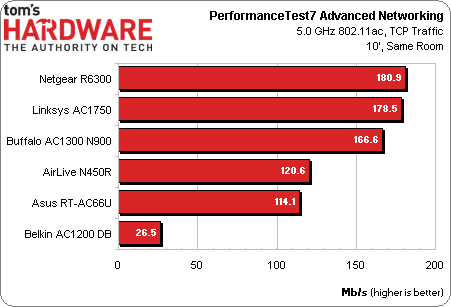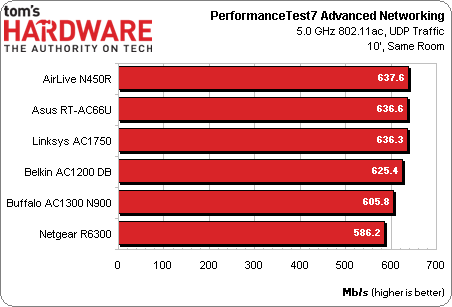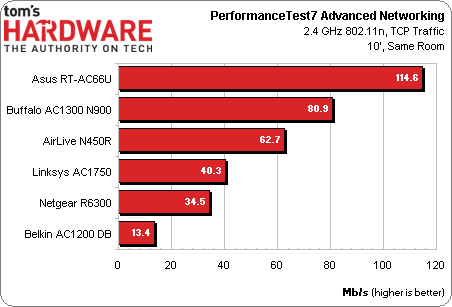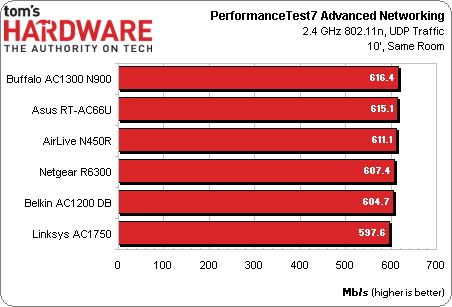Gigabit Wireless? Five 802.11ac Routers, Benchmarked
Five years ago, we didn't have homes with a dozen wireless nodes and the need to run HD video to multiple screens. Today we do. Our 802.11n networks, especially on the 2.4 GHz band, are swamped. Can 802.11ac save the day? We test six routers to find out.
Results: PerformanceTest 7, Same-Room
Why you can trust Tom's Hardware
PerformanceTest 7’s network test is similar to IxChariot in some ways, and it provides a graphically friendly way to cross-check other benchmark results. Here, in our 5.0 GHz TCP same-room test, we see Asus pull back a bit, even slipping in behind AirLive. Buffalo, Linksys, and Netgear all perform in the 165 to 180 Mb/s range, which, as a general average, meshes well with what we saw in our 2 GB transfer tests. In fact, Asus is the only player here that sees a significant difference between the two benchmarks.
In moving to UDP, throughput suddenly skyrockets, then crashes into some sort of bottleneck. Netgear's R6300 is the only router to not pass the 600 Mb/s mark.
To double-check our assumption and find out why traffic was maxing out, we went to David Wren, the creator of PerformanceTest.
“My guess at what is happening is that the device driver is just accepting an unlimited amount of data, then what can’t be sent with the available bandwidth gets thrown away,” he replied. “UDP was designed for tasks like streaming video and VoIP. So it would be like trying to push a super high definition video across the link, but on the receiving side you find that five out of every six video frames didn’t make it. But from the point of view of the sending application, everything is sent. In real life situations UDP is not used for transmitting as much data as possible as fast as possible. It is used when data needs to arrive on time, meaning that lost data isn’t worth recovering (or retransmitting) because you know that new data, e.g., the next frame of the streaming video, will arrive soon enough. You might find the CPU or PCI bus maxed out at 600 Mb/s, preventing even more data from not being transmitted.”
When we inquired as to why IxChariot’s UDP data might be so much slower than PerformanceTest 7’s (as you’ll see in a bit), Wren was quick to point out that he has never used or investigated IxChariot. However, he suggested this:
“From what I have read here, it looks like [Ixia] have implemented (by hand) their own version of TCP (with ACKs, sliding windows, and retransmissions) on top of UDP. Quote: ‘...This datagram protocol is a subset of the functionality TCP provides to ensure that data is received reliably....’ Which doesn’t really make sense to me, as no one in real life would do this. If you want a reliable connection, then you use TCP. If you want a lossy connection, then you use UDP. If I understand their paper, they are really measuring two different versions of TCP, the full Winsock implementation and their own custom coded TCP-like protocol.”
Switching to 2.4 GHz TCP, we again nose dive well below 802.11ac levels, just as in our 2 GB transfer tests. Asus easily trounces the field, with Buffalo coming in second and trailing by over 40 percent. So far, we’re having a hard time reconciling the 802.11n performance of these units, as we’ve seen prior-year models that perform better on 2.4 GHz for half the price.
In the 2.4 GHz UDP test, Netgear recovers into the 600+ Mb/s range, with overall scores running only slightly lower than in our 5 GHz pass.
Current page: Results: PerformanceTest 7, Same-Room
Prev Page Results: 2 GB Folder Copy Next Page Results: PerformanceTest 7, Across-HouseGet Tom's Hardware's best news and in-depth reviews, straight to your inbox.
-
boulbox Well, i can't wait until i can make my router give wifi all the way to my to my work area.(only a few blocks away)Reply -
I've tested both the R6300 and the RT-AC66U in my home. The R6300 beats it hands down. The average homes won't have the traffic that your artificial software creates. Even your tests show that R6300 in 5ghz mode is faster. People will buy these for gaming and HD movie viewing and the R6300 has better range as well. I've paired my R6300 with an ASUS PCE-AC66 desktop wireless AC adapter and I can acheive 30 MB/S (megabytes) to my HTPC in a 2 story house. That's an insane speed. The RT-AC66U only managed about 15 to 18 MB/s. Also make sure the R6300 has the latest firmware, which is V1.0.2.38_1.0.33. But in conclusion, the R6300 and the RT-AC66U are like a SRT Viper and ZR1 Vette. They are both great pieces of hardware to fit most users needs. Get the ASUS If you got a ton of traffic and a lot of 2.4 ghz devices. Grab the R6300 if you are looking for a friendly setup, max speed, and max range.Reply
-
fwupow Man it sure sucks when you type a long comment and it gets vaporized cuz you weren't logged in.Reply -
DeusAres I'd be happy with a 2Mb/s connection. It'd be better than this horrible 512 Kb/s connection I have now. At least then, I may actually be able to watch youtube vids in 360p.Reply -
fwupow Here's the gist of what I typed before it was rudely vaporized.Reply
I have a dual-band router (Netgear N600). I also purchased a couple of dual-band client USB adapters Linksys AE2500 or something to that effect.
So the USB adapter works fine for a desktop, but having that crap sticking out the side of a laptop, netbook or tablet? Busted in 10 minutes. I hooked one up to my netbook and fried it within a couple of weeks because I'm a Netbook in bed guy. You wouldn't think it could get so hot from a USB port but it does.
So the reality is that you have all these devices that can't be upgraded to dual-band and enjoy very little if any benefit from the new-fangled dual-band router.
The other beef I have with routers is that they're terrible with the way they split up bandwidth between multiple devices. Instead of responsively reassigning bandwidth to the device that needs it, the router continues to reserve a major slice for a device that I'm not using.
If you live in an apartment building, it's actually rather rude to use the full 300Mbps capacity of the wireless N band, since you may well succeed in effectively shutting your neighbor down. There's so much happening in the 2.4GHz band nowadays, it's unreal. Your own cordless keyboards/mice/controllers etc can malfunction from being unable to get a packet in edgewise.
For these dual-band routers to be really useful, we need manufacturers of smartphones, tablets, laptops, netbook and such to build dual-band clients into them because adding the functionality with some sort of dongle just doesn't work. -
memadmax I was a 802.11g and n "adoption" tester....Reply
Never again...
I'll give ac a year or two before I jump on it... -
SteelCity1981 my wireless N produces 300 Megabits which would equal around 37 Megabytes. My highspeed internet doesn't come cloe to reaching 37 megabytes and i don't transfer tons of files wirelesly and my wi-fi rangs is pretty good .So i'm perfectly fine with my 300MB N wireless router right now. Besides that none of my devices spport ac anyhow so it would get bottlenecked from reaching its full potential.Reply -
chuckchurch iknowhowtofixit"Folks, the time to start your 802.11ac adoption is now."I think this review proved that it is time to wait for 2nd generation wireless AC routers to appear before rushing to purchase.Reply
Exactly. The 'client' adapter they used if anyone didn't catch it was a Cisco/Linksys router-sized device. Not practical by any means. It'd be totally insane to make any product recommendations prior to real client adapters being available, or more accurately, embedded ones are available. I think a wireless salesman wrote this article.



